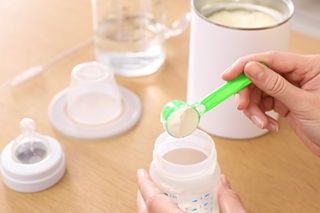Private Wells and Drinking Water Safety and Infants
Explore Other Kids and Climate Health Impacts
Find information on how climate change can affect water safety and children’s health. Start by reading the fictional story of an infant who is affected by waterborne illness and learn how similar situations can affect kids across the country. Also get tools to help families prepare and cope with outcomes from climate-related activity. Finally, check out the regional spotlight.
Alejandra's Story
Baby Alejandra's family live in a rural community and depends on a well for their drinking water supply. Her parents use powdered formula mixed with water from the family's private well to feed Alejandra. After a few days of heavy rainfall, the family has to rush the infant to a hospital because her skin starts to appear bluish around her eyes and mouth. Alejandra recovers and the family begins to get their well water tested regularly.

Blue Baby Syndrome happens when babies don’t have enough oxygen in their blood. This can happen when their water is contaminated by nitrates which is something that is more likely to occur in more places due to climate change. There are steps that we can take to help protect babies like Alejandra.
Climate Change Impacts
- Groundwater-sourced drinking water is becoming contaminated because standing floodwaters leak into wellheads and percolate into well fields.
- Fertilizers and pesticides can make their way into water supplies due to flooding in agricultural areas, leading to high levels of nitrogen in groundwater.1 Thawing permafrost, river erosion, and flooding associated with climate change all stand to worsen runoff.
Impacts on Infant's Health
- Children are particularly sensitive to waterborne microbial contaminants, such as Giardia, Cryptosporidium, and E. coli, because their immune systems are less developed than those of most adults.2 Microbial contamination of well water can also be exacerbated by rising temperatures.3
- Contaminants like arsenic are also commonly found in well water4 and can pose health risks, with short-term health effects including nausea, vomiting, abdominal pain, and diarrhea. Effects of long-term, extensive exposure to arsenic include adverse neurological effects such as learning disabilities, behavior difficulties, certain types of cancers, and lowered IQ. Fetuses, infants, and children are particularly vulnerable to the potential harmful effects from arsenic exposure because of their smaller body sizes, rapid metabolism and growth.7
- Nitrate contamination in well water can come from a variety of sources.8 High levels of nitrate in drinking water can be extremely dangerous for infants when consumed and can lead to “Blue Baby Syndrome.”9
What can I do?
- DO keep emergency stocks of bottled water on hand. Bottled water can be used to mix powdered infant formula.
- DO have your well water tested. There are no requirements for testing private water wells, but it is recommended that users of private wells have their water tested. This is especially important if you have an infant or expect to become pregnant. Learn more about health concerns related to nitrate and nitrite in private well water. (pdf)
- DO test well water between April and July or after flooding. Nitrate and nitrite levels are typically highest between April and July, and testing yearly during these months can help mitigate potential exposures. Also test wells after flooding, especially if they were covered by floodwater. Learn more about the importance of testing private well water. (pdf) Find private drinking water well programs in your state. You can also call the National Ground Water Association’s Private Well Owner Hotline at 855-420-9355 (855-H20-Well)
What should I not do?
- DON'T mix well water containing more than 10 milligrams per liter of nitrate with infant formula or food. Contact your local health organization for help interpreting the results of well water testing. If well water exceeds this limit or if you are uncertain of its safety, use bottled water, water from public water supplies (which require safety testing), or tested water from a deeper well. Learn more about well water safety and children.
- DON'T drink contaminated well water. Contact your local health department for advice. Different contaminant types require different treatment methods. Find your local health department.
The U.S. Caribbean includes Puerto Rico and the U.S. Virgin Islands.
- Around 50% of Alaska’s population relies on groundwater as a source of drinking water. This number is as high as 90% among rural residents.10
- Alaska has been experiencing unprecedented drought and reduced stream and river flows, which can increase the concentration of contaminants in drinking water and lead to slower well recharge.11 Changes in snowpack and snowmelt can change the availability of fresh water.
- Along the coast of Puerto Rico, large withdrawals of groundwater have led to seawater encroachment, which renders well water unsafe to drink.12
- Drought in Puerto Rico has also become more common, which can decrease the availability of water in aquifers.13
